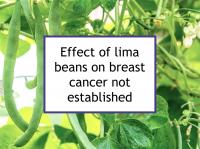Lima beans are the seeds of the legume Phaseolus lunatus or Phaseolus limensis. Lima beans are a significant dietary source of fiber, manganese and molybdenum. They are also a source of copper, folate, iron, magnesium, protein, thiamin (B1) and pyridoxine (B6), as well as a small amount of the phytoestrogens coumestrol and genistein.
Lima beans have been shown to have antioxidant, antimicrobial, antifungal, antibacterial and hypoglycemic actions, as well as improving cholesterol. Lima beans should not be consumed raw since raw lima beans contain cyanide compounds. The cyanide is released as gas when the beans are cooked, rendering the beans safe to eat.
Breast cancer-related effects of eating lima beans
A peptide isolated from the large lima bean (Phaseolus limensis) has been found to have antiproliferative activity in human liver cancer and neuroblastoma (nerve cancer) cells. Lima bean lectin has been reported to inhibit angiogenesis (the process by which tumors send out signals to induce surrounding normal tissues to grow new blood vessels into the tumor), but we have found little evidence on this topic with respect to breast cancer. In fact, boiling lima beans removes the lectin content. On the other hand, as explained below, the copper content of lima beans could potentially promote angiogenesis in existing breast cancer.
Lima bean estrogenic properties
Lima beans are a source of the phytoestrogens coumestrol and genistein. Phytoestrogens are structurally and functionally similar to mammalian estrogens and able to bind to estrogen receptors. When phytoestrogens bind to cell receptors, they can have either anti-estrogenic activity (which reduces ER+ cell proliferation and growth), or estrogenic activity (promoting ER+ cell proliferation and growth), or both (depending primarily on dosage).
Extracts of lima beans have been found to increase proliferation of hormone receptor positive (ER+/PR+) breast cancer cells. In and of itself, this is not strong evidence that lima bean consumption increases breast cancer risk in women, however it is a result that requires further study and clarification. Based on available evidence, it has not been established whether the phytoestrogens in lima beans are associated with reduced ER+ or increased ER+ breast cancer risk when lima beans are consumed.
Excess copper may promote metastasis
Cooked lima beans contain approximately 0.44 mg copper per cup. One 2024 study found that relatively high levels of copper in the urine of girls were associated with increased breast density two years after menarche. On the other hand, other studies have reported that while copper does appears to increase the risk of recurrence, it does not heighten risk of primary breast cancer significantly. Copper has been shown to promote angiogenesis and metastasis, especially in aggressive forms of breast cancer such as inflammatory (IBC), triple negative (ER-/PR-/HER2-), and HER2-positive (HER2+) breast cancer.
Although copper is a vital nutrient, breast cancer patients and survivors who are not anemic should probably not exceed the RDA (recommended dietary allowance) of approximately 0.9 mg. High copper foods such as calf's liver and beef liver should be avoided. Foods with moderate copper content, such as lima beans, shellfish, textured soy protein, chocolate, most tree nuts, and sunflower seeds also should be limited or avoided. Copper consumption should be reserved for foods such as walnuts, which contain approximately 0.45 mg copper per ounce, but which have exceptional anti-breast cancer properties.
Bottom line
Dry beans (Phaseolus vulgaris) such as kidney beans or black beans, which have well-established anti-cancer properties, are a better choice than lima beans.
Additional comments
Lima beans are also known as butter beans. As noted above, lima beans should not be consumed raw. Caution is also advised when eating these beans overseas. In the U.S., commercially grown varieties of lima beans are restricted to those with very low levels of cyanide compounds, while lima beans in some other countries may have far higher levels.
Lima beans are a source of amygdalin (laetrile)
One of lima bean's cyanide compounds is amygdalin, the basis for laetrile (see almonds for a discussion of laetrile (vitamin B17)). Consuming foods that contain cyanide (such as raw or undercooked lima beans) in combination with laetrile treatment can increase the possibility of cyanide poisoning.
Sources of information provided in this webpage
The information above, which is updated continually as new research becomes available, has been developed based solely on the results of academic studies. Clicking on any of the underlined terms will take you to its tag or webpage, which contain more extensive information.
Below are links to 20 studies concerning this food and its components. For a more complete list of studies, please click on lima beans.
